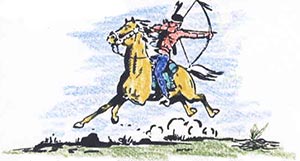|

This story was published in Radio Recall, the journal of the Metropolitan Washington Old-Time Radio Club, published six times per year.
Click here to return to the index of selected articles.
|
|
 STRAIGHT ARROW: STRAIGHT ARROW:
The Definitive Radio Log and Resource Guide for that Legendary Indian Figure on the Trail of Justice
By William H. Harper
BearManor Media, 2007, 171 pp., $18.95
Reviewed by Maury Cagle
(From Radio Recall, August 2007)
Few fictional characters-print, radio, or television-enter the vernacular of the day and stay there for 60 years. Such is the case with “Straight Arrow,” whose name is used today by millions to describe someone above reproach, but who have no idea of the term's origin.
Straight Arrow was a juvenile western adventure show, which was popular with young listeners from May of 1948 to June, 1951. The show was the story of Steve Adams, a young man of Comanche descent, raised on a ranch as a white man.
Echoing an old Indian legend, in times of trouble Adams doffs his rancher's clothes, puts on Indian garb and war paint and becomes Straight Arrow. This transformation occurs in his secret cave, from which he rides on the magnificent golden palomino Fury in the cause of justice, urging his steed on with the cry, “Kaneewah, Fury!”
This book is the result of one man's fascination with a single show from the golden days of Old Time Radio. Bill Harper's dedication led him on a 20-year research project into every aspect of the Straight Arrow show.

Harper clarifies a common misperception about the dual role of Steve Adams and the hero, Straight Arrow. It is not that white rancher Adams puts on an Indian costume, but rather that Adams sheds his assumed identity to reveal his true nature. His dual role is known only to his sidekick, Packy McCloud.
Adams/Straight Arrow was played for the entire run of the show by Howard Culver, who even changed his voice as the hero changed identities. All of the programs were written by Sheldon Stark, and Frank Bingman was the announcer-narrator. Milton Charles supplied the organ music, and created a distinctive sound that simulated an arrow in flight, which became an integral part of the show. All of the key personalities are profiled in detail.
The program began on the West Coast Don Lee network, then went coast-to-coast on Mutual. Throughout its time on the air, the program was sponsored by Nabisco Shredded Wheat.
In the beginning, Nabisco ran a contest to name Straight Arrow's horse, resulting in 50,000 boxtops and suggested names. Many Straight Arrow premiums were offered, including “Injun-Uity” cards, separating the biscuits in packages of Shredded Wheat. Others were a headband with two red feathers, a war drum, golden tie clip, and a bandanna. All the premiums are described in dettail.
Harper also notes the comic book and newspaper comic strip versions of Straight Arrow, as well as the live promotions of the main character in some of the book's many interesting illustrations and photographs.
The heart of the book is a detailed log of all 292 radio programs in the series. This is a real service, since only nine audio versions are known to exist.
While the book needs editing to address minor problems, Harper has created the definitive volume on a very popular, but long overlooked OTR series.
Straight Arrow is available from BearManor Media, P.O. Box 71426, Albany GA 31708 for $18.95 plus $3.00 postage, or online at www.bearmanormedia.com.
|